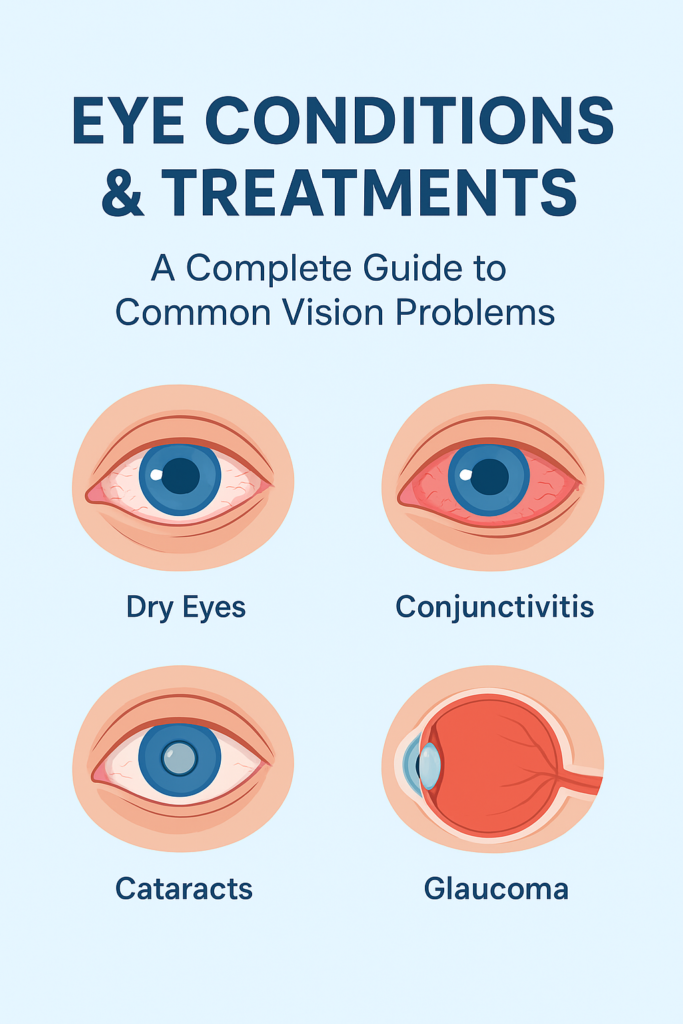Introduction: Why Understanding Eye Conditions Matters
Eye Conditions and Treatments are essential topics for anyone who wants to maintain healthy vision throughout life. From common issues like dry eyes and allergies to more serious diseases such as glaucoma or cataracts, understanding these conditions helps you detect early symptoms and choose the right treatment. In this complete guide, we’ll explore the most frequent eye problems, their causes, and practical ways to protect and improve your eyesight naturally.
1. Dry Eyes (Keratoconjunctivitis Sicca)
Dry eyes occur when the tear film is inadequate in either quantity or quality. Symptoms include burning, stinging, redness, and blurry vision.
Treatment:
- Artificial tears
- Warm compresses
- Omega-3 fatty acid supplements

2. Conjunctivitis (Pink Eye)
Conjunctivitis is an inflammation of the conjunctiva, often caused by infections, allergies, or irritants. Symptoms include redness, discharge, and itchiness.
Treatment:
- Antibiotic drops (for bacterial infections)
- Antihistamine drops (for allergies)
- Good hygiene to prevent spreading
3. Cataracts
Cataracts cause the eye’s natural lens to become cloudy, leading to blurry or dim vision, especially at night. It is a leading cause of blindness worldwide.
Treatment:
- Early stage: Brighter lighting, stronger glasses
- Advanced stage: Cataract surgery
4. Glaucoma
Glaucoma is caused by damage to the optic nerve, often due to high intraocular pressure. It can lead to irreversible blindness if untreated.
Treatment:
- Prescription eye drops
- Laser therapy
- Surgery in severe cases

5. Age-Related Macular Degeneration (AMD)
AMD affects the central retina (macula) and is a leading cause of vision loss among people over 50.
Treatment:
- Nutritional supplements (AREDS2 formula: Lutein, Zeaxanthin, Vitamins C & E, Zinc)
- Laser therapy or injections for wet AMD
👁️ Related Reading:
6. Retinal Detachment
A medical emergency where the retina separates from the underlying tissue. Symptoms: sudden flashes, floaters, and a shadow over vision.
Treatment:
- Laser surgery
- Cryotherapy
- Vitrectomy or scleral buckle surgery
7. Astigmatism
Astigmatism is an irregular curvature of the cornea or lens that causes distorted vision.
Treatment:
- Glasses or contact lenses
- Refractive surgery (LASIK, PRK)
8. Diabetic Retinopathy
High blood sugar damages blood vessels in the retina, leading to vision problems.
Treatment:
- Control of blood sugar
- Laser treatment
- Anti-VEGF injections
9. Presbyopia
Presbyopia is age-related difficulty focusing on near objects, typically starting after age 40.
Treatment:
- Reading glasses
- Multifocal lenses
- LASIK or lens replacement surgery
Useful Tips for Protecting Your Eyes
- Follow the 20-20-20 rule: Every 20 minutes, look at something 20 feet away for 20 seconds.
- Eat a diet rich in leafy greens, carrots, and fish oil.
- Wear sunglasses with UV protection daily.
- Schedule annual eye exams, even if you have no symptoms.
Frequently Asked Questions (FAQ)
1. What is the most common eye condition?
Dry eyes and refractive errors (like myopia, hyperopia, and astigmatism) are the most widespread globally.
2. Can cataracts be prevented?
While cataracts are age-related, wearing UV-protective sunglasses and eating antioxidant-rich foods may delay progression.
3. Is glaucoma curable?
Glaucoma cannot be cured, but treatments can slow or stop progression if caught early.
4. What are early warning signs of retinal detachment?
Sudden flashes, new floaters, or a curtain-like shadow in your vision.
5. How often should I see an eye doctor?
At least once every 1–2 years, or more frequently if you have risk factors such as diabetes or family history.
🩺 Conclusion
Understanding eye conditions and treatments is the first step toward protecting your long-term vision. Many eye problems — from dryness and allergies to glaucoma, cataracts, or macular degeneration — can be managed effectively when detected early. Regular eye exams, a nutrient-rich diet, proper screen habits, and UV protection are simple yet powerful ways to preserve eyesight.
If you notice sudden changes in vision, persistent irritation, or discomfort, seek professional advice immediately. Your eyes are delicate and irreplaceable — by staying informed and proactive, you can prevent complications and enjoy clear, healthy vision for years to come.



